driver seat adjustment SKODA SUPERB 2006 1.G / (B5/3U) Owner's Manual
[x] Cancel search | Manufacturer: SKODA, Model Year: 2006, Model line: SUPERB, Model: SKODA SUPERB 2006 1.G / (B5/3U)Pages: 281, PDF Size: 12.67 MB
Page 12 of 281
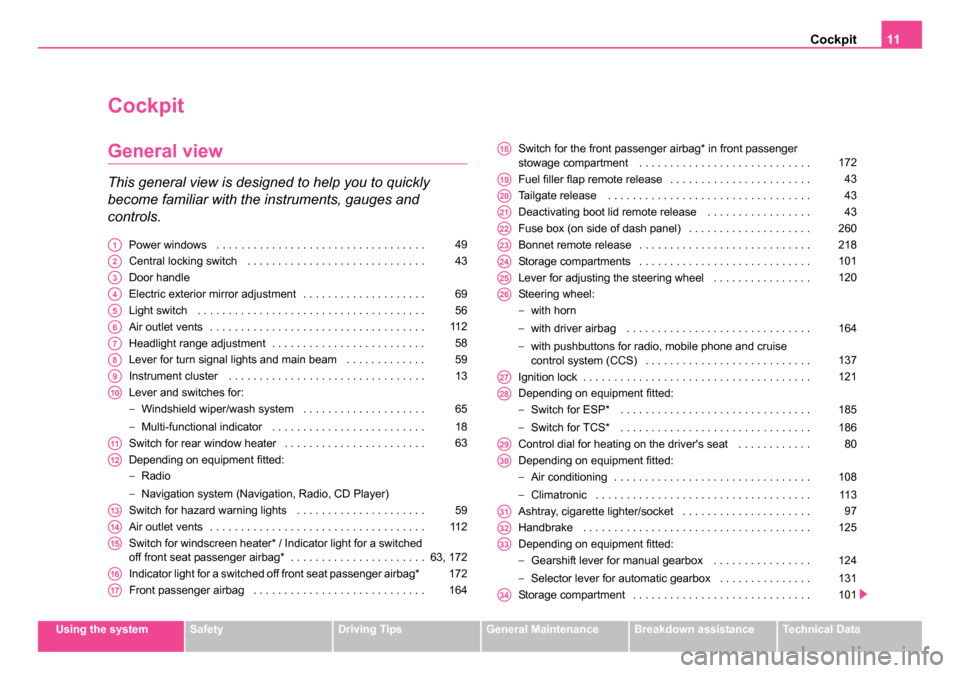
Cockpit11
Using the systemSafetyDriving TipsGeneral MaintenanceBreakdown assistanceTechnical Data
Cockpit
General view
This general view is designed to help you to quickly
become familiar with the instruments, gauges and
controls.
Power windows . . . . . . . . . . . . . . . . . . . . . . . . . . . . . . . . . .
Central locking switch . . . . . . . . . . . . . . . . . . . . . . . . . . . . .
Door handle
Electric exterior mirror adjustment . . . . . . . . . . . . . . . . . . . .
Light switch . . . . . . . . . . . . . . . . . . . . . . . . . . . . . . . . . . . . .
Air outlet vents . . . . . . . . . . . . . . . . . . . . . . . . . . . . . . . . . . .
Headlight range adjustment . . . . . . . . . . . . . . . . . . . . . . . . .
Lever for turn signal lights and main beam . . . . . . . . . . . . .
Instrument cluster . . . . . . . . . . . . . . . . . . . . . . . . . . . . . . . .
Lever and switches for:
−Windshield wiper/wash system . . . . . . . . . . . . . . . . . . . .
− Multi-functional indicator . . . . . . . . . . . . . . . . . . . . . . . . .
Switch for rear window heater . . . . . . . . . . . . . . . . . . . . . . .
Depending on equipment fitted:
− Radio
− Navigation system (Navigation, Radio, CD Player)
Switch for hazard warning lights . . . . . . . . . . . . . . . . . . . . .
Air outlet vents . . . . . . . . . . . . . . . . . . . . . . . . . . . . . . . . . . .
Switch for windscreen heater* / Indicator light for a switched
off front seat passenger airbag* . . . . . . . . . . . . . . . . . . . . . .
Indicator light for a switched off front seat passenger airbag*
Front passenger airbag . . . . . . . . . . . . . . . . . . . . . . . . . . . . Switch for the front passenger airbag* in front passenger
stowage compartment . . . . . . . . . . . . . . . . . . . . . . . . . . . .
Fuel filler flap remote release . . . . . . . . . . . . . . . . . . . . . . .
Tailgate release . . . . . . . . . . . . . . . . . . . . . . . . . . . . . . . . .
Deactivating boot lid remote release . . . . . . . . . . . . . . . . .
Fuse box (on side of dash panel) . . . . . . . . . . . . . . . . . . . .
Bonnet remote release . . . . . . . . . . . . . . . . . . . . . . . . . . . .
Storage compartments . . . . . . . . . . . . . . . . . . . . . . . . . . . .
Lever for adjusting the steering wheel . . . . . . . . . . . . . . . .
Steering wheel:
−
with horn
− with driver airbag . . . . . . . . . . . . . . . . . . . . . . . . . . . . . .
− with pushbuttons for radio, mobile phone and cruise
control system (CCS) . . . . . . . . . . . . . . . . . . . . . . . . . . .
Ignition lock . . . . . . . . . . . . . . . . . . . . . . . . . . . . . . . . . . . . .
Depending on equipment fitted:
− Switch for ESP* . . . . . . . . . . . . . . . . . . . . . . . . . . . . . . .
− Switch for TCS* . . . . . . . . . . . . . . . . . . . . . . . . . . . . . . .
Control dial for heating on the driver's seat . . . . . . . . . . . .
Depending on equipment fitted:
− Air conditioning . . . . . . . . . . . . . . . . . . . . . . . . . . . . . . . .
− Climatronic . . . . . . . . . . . . . . . . . . . . . . . . . . . . . . . . . . .
Ashtray, cigarette lighter/socket . . . . . . . . . . . . . . . . . . . . .
Handbrake . . . . . . . . . . . . . . . . . . . . . . . . . . . . . . . . . . . . .
Depending on equipment fitted:
− Gearshift lever for manual gearbox . . . . . . . . . . . . . . . .
− Selector lever for automatic gearbox . . . . . . . . . . . . . . .
Storage compartment . . . . . . . . . . . . . . . . . . . . . . . . . . . . . A149
A243
A3
A469
A556
A611 2
A758
A859
A913
A10
65
18
A1163
A12
A1359
A1411 2
A1563, 172
A16172
A17164
A18172
A1943
A2043
A2143
A22260
A23218
A24101
A25120
A26
164
137
A27121
A28
185
186
A2980
A30
108
11 3
A3197
A32125
A33
124
131
A34101
NKO B5 20.book Page 11 Monday, July 3, 2006 2:09 PM
Page 59 of 281
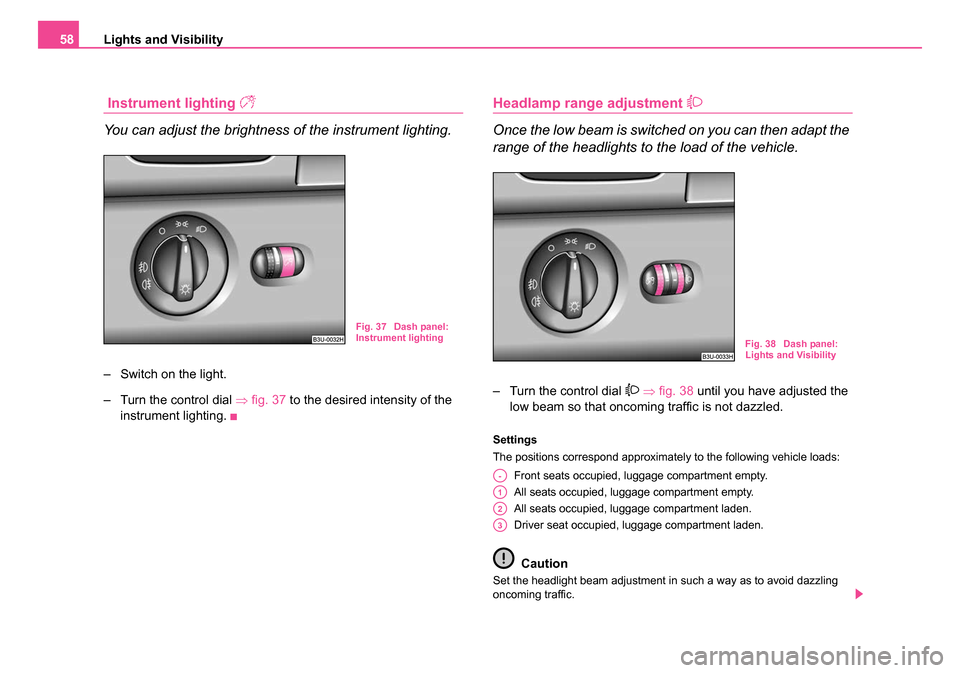
Lights and Visibility
58
Instrument lighting
You can adjust the brightness of the instrument lighting.
– Switch on the light.
– Turn the control dial ⇒fig. 37 to the desired intensity of the
instrument lighting.
Headlamp range adjustment
Once the low beam is switched on you can then adapt the
range of the headlights to the load of the vehicle.
– Turn the control dial ⇒ fig. 38 until you have adjusted the
low beam so that oncoming traffic is not dazzled.
Settings
The positions correspond approximately to the following vehicle loads:
Front seats occupied, luggage compartment empty.
All seats occupied, luggage compartment empty.
All seats occupied, luggage compartment laden.
Driver seat occupied, luggage compartment laden.
Caution
Set the headlight beam adjustment in such a way as to avoid dazzling
oncoming traffic.
Fig. 37 Dash panel:
Instrument lighting
Fig. 38 Dash panel:
Lights and Visibility
A-
A1
A2
A3
NKO B5 20.book Page 58 Monday, July 3, 2006 2:09 PM
Page 72 of 281

Seats and Stowage71
Using the systemSafetyDriving TipsGeneral MaintenanceBreakdown assistanceTechnical Data
Seats and Stowage
Front seats
Basic information
The front seats have a wide range of different settings and can thus be
matched to the physical characteristics of the driver and front passenger.
Correct adjustment of the seats is particularly important for
•safely and quickly reaching the controls,
•a relaxed, fatigue-free body position,
•achieving the maximum protection offered by the seat belts and
the airbag system.
The chapters which follow describe the procedure which you should adopt
for adjusting the seats.
WARNING
•Never transport more occupants than the maximum seating in
the vehicle.
•Each occupant must correctly fasten the seat belt belonging to
the seat. Children must be fastened ⇒page 174, “Transporting
children safely” with a suitable restraint system.
•The front seats and the head restraints must always be adjusted
to match the body size of the seat occupant as well as the seat belts
must always be correctly fastened in order to provide an optimal
protection for you and your occupants.
•Always keep your feet in the footwell when the car is being
driven - never place your feet on the instrument panel, out of the
window or on the surfaces of the seats. This is particularly impor- tant for the front seat passenger. You will be exposed to increased
risk of injury if it becomes necessary to apply the brake or in the
event of an accident. If an airbag is deployed, you may suffer fatal
injuries when adopting an incorrect seated position!
•It is important for the driver and front passenger to maintain a
distance of at least 25 cm from the steering wheel or dash panel.
Not maintaining this minimum distance will mean that the airbag
system will not be able to properl y protect you - hazard! The front
seats and the head restraints must always also be correctly
adjusted to match the body size of the occupant.
•Ensure that there are no objects in the footwell as any objects
may get behind the pedals during a driving or braking manoeuvre.
You would then no longer be able to operate the clutch, to brake or
accelerate.
WARNING (continued)
NKO B5 20.book Page 71 Monday, July 3, 2006 2:09 PM
Page 74 of 281

Seats and Stowage73
Using the systemSafetyDriving TipsGeneral MaintenanceBreakdown assistanceTechnical Data
Adjusting front seats electrically*
Adjusting seats
Adjusting seat
– Adopt the correct seated position ⇒page 71.
– Press switch or ⇒fig. 55 in the direction of the desired
setting.
– Turn the handwheel until you have set the most comfort- able curvature of the seat upholstery in the area of your spine.
Switch is operated in order to move the seat up/down and
forward/back, while switch is operated in order to move the backrest
forward or back.
You can adjust the lumbar support only mechanically with the handwheel
.
WARNING
•Only adjust the driver seat when the vehicle is stationary - risk
of injury!
•Caution when adjusting the seat! You may suffer injuries or
bruises as a result of adjusting the seat without paying proper
attention.
•In view of the fact that the seats can also be adjusted when the
ignition is switched off (even when ignition key withdrawn), you
should never leave children unattended in the car.
•The backrests must not be angled too far back when driving
otherwise this will affect proper operation of the seat belts and of
the airbag system - risk of injury!
Note
If the movement of the seat is inadvertently interrupted during an adjust-
ment, once again press the switch in the appropriate direction and
continue with the adjustment of the seat to the end.Fig. 55 Side view:
controls for adjusting
seat
AAAB
AC
AAAB
AC
NKO B5 20.book Page 73 Monday, July 3, 2006 2:09 PM
Page 152 of 281
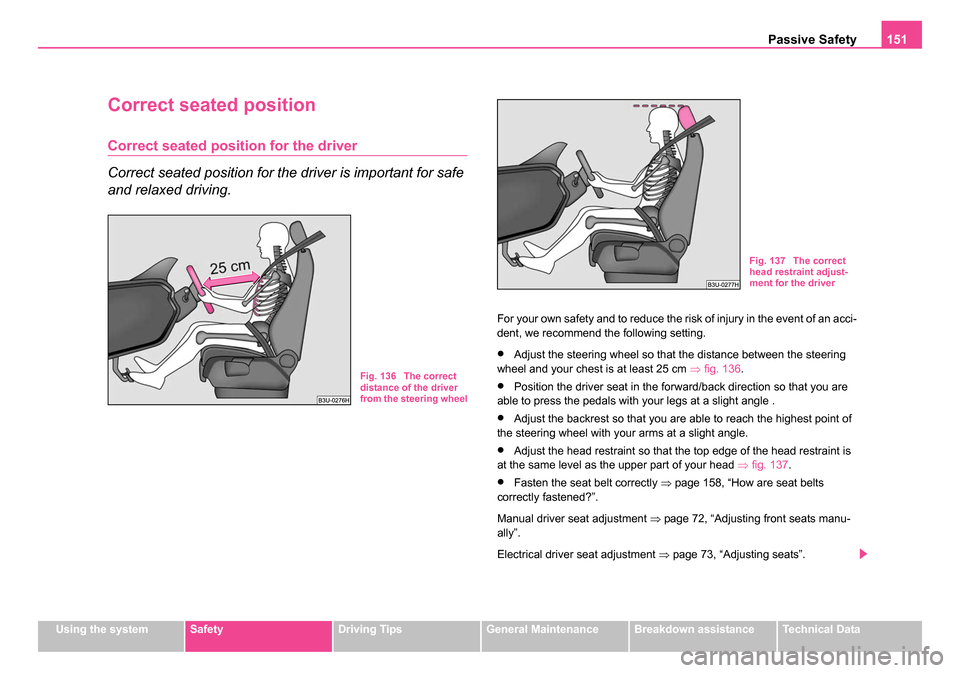
Passive Safety151
Using the systemSafetyDriving TipsGeneral MaintenanceBreakdown assistanceTechnical Data
Correct seated position
Correct seated position for the driver
Correct seated position for the driver is important for safe
and relaxed driving.
For your own safety and to reduce the risk of injury in the event of an acci-
dent, we recommend the following setting.
•Adjust the steering wheel so that the distance between the steering
wheel and your chest is at least 25 cm ⇒fig. 136 .
•Position the driver seat in the forward/back direction so that you are
able to press the pedals with your legs at a slight angle .
•Adjust the backrest so that you are able to reach the highest point of
the steering wheel with your arms at a slight angle.
•Adjust the head restraint so that the top edge of the head restraint is
at the same level as the upper part of your head ⇒fig. 137 .
•Fasten the seat belt correctly ⇒page 158, “How are seat belts
correctly fastened?”.
Manual driver seat adjustment ⇒page 72, “Adjusting front seats manu-
ally”.
Electrical driver seat adjustment ⇒page 73, “Adjusting seats”.
Fig. 136 The correct
distance of the driver
from the steering wheel
Fig. 137 The correct
head restraint adjust-
ment for the driver
NKO B5 20.book Page 151 Monday, July 3, 2006 2:09 PM
Page 153 of 281
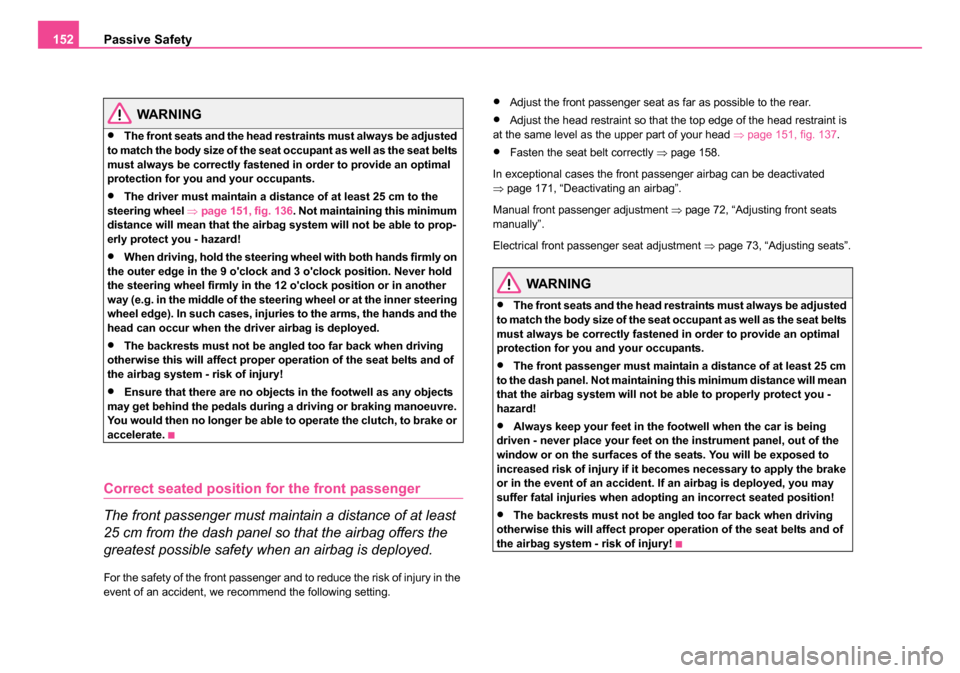
Passive Safety
152
WARNING
•The front seats and the head restraints must always be adjusted
to match the body size of the seat occupant as well as the seat belts
must always be correctly fastened in order to provide an optimal
protection for you and your occupants.
•The driver must maintain a distan ce of at least 25 cm to the
steering wheel ⇒page 151, fig. 136 . Not maintaining this minimum
distance will mean that the airbag system will not be able to prop-
erly protect you - hazard!
•When driving, hold the steering wheel with both hands firmly on
the outer edge in the 9 o'clock and 3 o'clock position. Never hold
the steering wheel firmly in the 12 o'clock position or in another
way (e.g. in the middle of the steering wheel or at the inner steering
wheel edge). In such cases, injuries to the arms, the hands and the
head can occur when the driver airbag is deployed.
•The backrests must not be angled too far back when driving
otherwise this will affect proper operation of the seat belts and of
the airbag system - risk of injury!
•Ensure that there are no objects in the footwell as any objects
may get behind the pedals during a driving or braking manoeuvre.
You would then no longer be able to operate the clutch, to brake or
accelerate.
Correct seated position for the front passenger
The front passenger must maintain a distance of at least
25 cm from the dash panel so that the airbag offers the
greatest possible safety when an airbag is deployed.
For the safety of the front passenger and to reduce the risk of injury in the
event of an accident, we recommend the following setting.
•Adjust the front passenger seat as far as possible to the rear.
•Adjust the head restraint so that the top edge of the head restraint is
at the same level as the upper part of your head ⇒page 151, fig. 137 .
•Fasten the seat belt correctly ⇒page 158.
In exceptional cases the front passenger airbag can be deactivated
⇒ page 171, “Deactivating an airbag”.
Manual front passenger adjustment ⇒page 72, “Adjusting front seats
manually”.
Electrical front passenger seat adjustment ⇒page 73, “Adjusting seats”.
WARNING
•The front seats and the head restraints must always be adjusted
to match the body size of the seat occupant as well as the seat belts
must always be correctly fastened in order to provide an optimal
protection for you and your occupants.
•The front passenger must maintain a distance of at least 25 cm
to the dash panel. Not maintaining this minimum distance will mean
that the airbag system will not be able to properly protect you -
hazard!
•Always keep your feet in the footwell when the car is being
driven - never place your feet on the instrument panel, out of the
window or on the surfaces of the seats. You will be exposed to
increased risk of injury if it becomes necessary to apply the brake
or in the event of an accident. If an airbag is deployed, you may
suffer fatal injuries when adopting an incorrect seated position!
•The backrests must not be angled too far back when driving
otherwise this will affect proper operation of the seat belts and of
the airbag system - risk of injury!
NKO B5 20.book Page 152 Monday, July 3, 2006 2:09 PM
Page 272 of 281
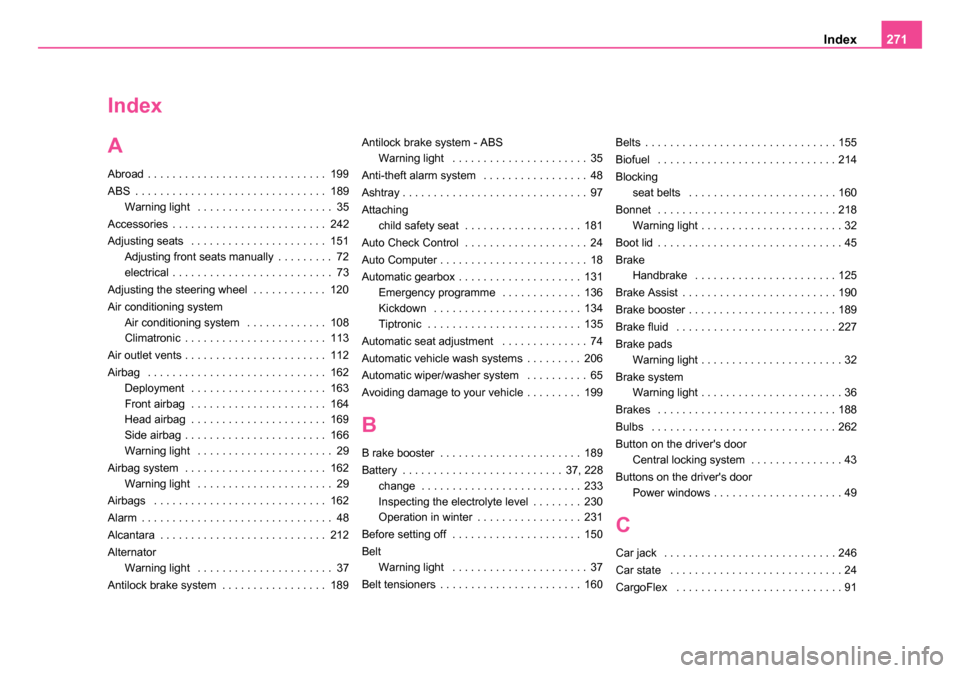
Index271
Index
A
Abroad . . . . . . . . . . . . . . . . . . . . . . . . . . . . . 199
ABS . . . . . . . . . . . . . . . . . . . . . . . . . . . . . . . 189
Warning light . . . . . . . . . . . . . . . . . . . . . . 35
Accessories . . . . . . . . . . . . . . . . . . . . . . . . . 242
Adjusting seats . . . . . . . . . . . . . . . . . . . . . . 151 Adjusting front seats manually . . . . . . . . . 72
electrical . . . . . . . . . . . . . . . . . . . . . . . . . . 73
Adjusting the steering wheel . . . . . . . . . . . . 120
Air conditioning system Air conditioning system . . . . . . . . . . . . . 108
Climatronic . . . . . . . . . . . . . . . . . . . . . . . 113
Air outlet vents . . . . . . . . . . . . . . . . . . . . . . . 112
Airbag . . . . . . . . . . . . . . . . . . . . . . . . . . . . . 162 Deployment . . . . . . . . . . . . . . . . . . . . . . 163
Front airbag . . . . . . . . . . . . . . . . . . . . . . 164
Head airbag . . . . . . . . . . . . . . . . . . . . . . 169
Side airbag . . . . . . . . . . . . . . . . . . . . . . . 166
Warning light . . . . . . . . . . . . . . . . . . . . . . 29
Airbag system . . . . . . . . . . . . . . . . . . . . . . . 162 Warning light . . . . . . . . . . . . . . . . . . . . . . 29
Airbags . . . . . . . . . . . . . . . . . . . . . . . . . . . . 162
Alarm . . . . . . . . . . . . . . . . . . . . . . . . . . . . . . . 48
Alcantara . . . . . . . . . . . . . . . . . . . . . . . . . . . 212
Alternator Warning light . . . . . . . . . . . . . . . . . . . . . . 37
Antilock brake system . . . . . . . . . . . . . . . . . 189 Antilock brake system - ABS
Warning light . . . . . . . . . . . . . . . . . . . . . . 35
Anti-theft alarm system . . . . . . . . . . . . . . . . . 48
Ashtray . . . . . . . . . . . . . . . . . . . . . . . . . . . . . . 97
Attaching child safety seat . . . . . . . . . . . . . . . . . . . 181
Auto Check Control . . . . . . . . . . . . . . . . . . . . 24
Auto Computer . . . . . . . . . . . . . . . . . . . . . . . . 18
Automatic gearbox . . . . . . . . . . . . . . . . . . . . 131 Emergency programme . . . . . . . . . . . . . 136
Kickdown . . . . . . . . . . . . . . . . . . . . . . . . 134
Tiptronic . . . . . . . . . . . . . . . . . . . . . . . . . 135
Automatic seat adjustment . . . . . . . . . . . . . . 74
Automatic vehicle wash systems . . . . . . . . . 206
Automatic wiper/washer system . . . . . . . . . . 65
Avoiding damage to your vehicle . . . . . . . . . 199
B
B rake booster . . . . . . . . . . . . . . . . . . . . . . . 189
Battery . . . . . . . . . . . . . . . . . . . . . . . . . . 37, 228 change . . . . . . . . . . . . . . . . . . . . . . . . . . 233
Inspecting the electrolyte level . . . . . . . . 230
Operation in winter . . . . . . . . . . . . . . . . . 231
Before setting off . . . . . . . . . . . . . . . . . . . . . 150
Belt Warning light . . . . . . . . . . . . . . . . . . . . . . 37
Belt tensioners . . . . . . . . . . . . . . . . . . . . . . . 160 Belts . . . . . . . . . . . . . . . . . . . . . . . . . . . . . . . 155
Biofuel . . . . . . . . . . . . . . . . . . . . . . . . . . . . . 214
Blocking
seat belts . . . . . . . . . . . . . . . . . . . . . . . . 160
Bonnet . . . . . . . . . . . . . . . . . . . . . . . . . . . . . 218 Warning light . . . . . . . . . . . . . . . . . . . . . . . 32
Boot lid . . . . . . . . . . . . . . . . . . . . . . . . . . . . . . 45
Brake Handbrake . . . . . . . . . . . . . . . . . . . . . . . 125
Brake Assist . . . . . . . . . . . . . . . . . . . . . . . . . 190
Brake booster . . . . . . . . . . . . . . . . . . . . . . . . 189
Brake fluid . . . . . . . . . . . . . . . . . . . . . . . . . . 227
Brake pads Warning light . . . . . . . . . . . . . . . . . . . . . . . 32
Brake system Warning light . . . . . . . . . . . . . . . . . . . . . . . 36
Brakes . . . . . . . . . . . . . . . . . . . . . . . . . . . . . 188
Bulbs . . . . . . . . . . . . . . . . . . . . . . . . . . . . . . 262
Button on the driver's door Central locking system . . . . . . . . . . . . . . . 43
Buttons on the driver's door Power windows . . . . . . . . . . . . . . . . . . . . . 49
C
Car jack . . . . . . . . . . . . . . . . . . . . . . . . . . . . 246
Car state . . . . . . . . . . . . . . . . . . . . . . . . . . . . 24
CargoFlex . . . . . . . . . . . . . . . . . . . . . . . . . . . 91
NKO B5 20.book Page 271 Monday, July 3, 2006 2:09 PM